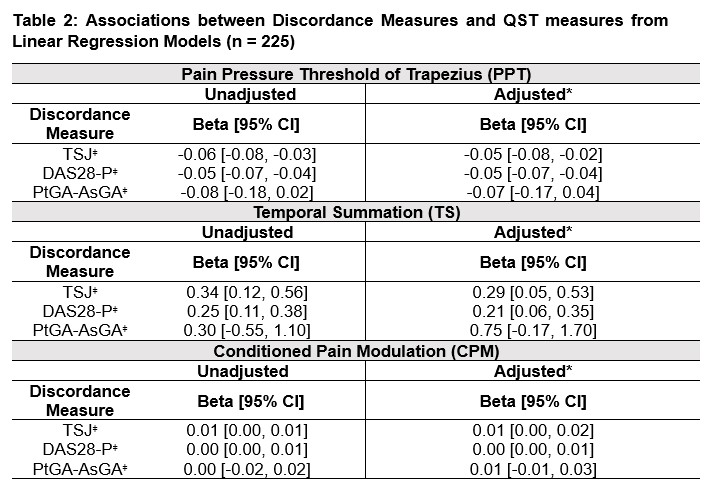Session Information
Date: Saturday, November 16, 2024
Title: Abstracts: Pain in Rheumatic Disease Including Fibromyalgia
Session Type: Abstract Session
Session Time: 1:00PM-2:30PM
Background/Purpose: Approximately one-third of patients with rheumatoid arthritis (RA) experience nociplastic pain, a type of pain that occurs due to abnormalities in the way the central nervous system regulates pain. There is a critical need to identify nociplastic pain in patients with RA because these patients tend to be less responsive to disease-modifying antirheumatic drugs (DMARDs) and have poor clinical outcomes. Furthermore, escalating DMARD therapy for pain would not be appropriate if the pain is due to nociplastic pain rather than due to RA-related mechanisms (ex: inflammation). Quantitative sensory tests (QST) are often used to assess nociplastic pain in research studies but may be challenging to implement in clinic. Discordance between subjective and objective components of composite disease activity measures have been proposed as indicators of nociplastic pain in RA. We hypothesize that higher discordance between disease activity measures is correlated with worse QST measures of nociplastic pain.
Methods: This study includes data from the Central Pain in Rheumatoid Arthritis (CPIRA) study, which enrolled patients with active RA starting a new DMARD from five academic medical centers in the U.S. Measures of discordance in disease activity were the tender minus swollen joint count (TSJ), proportion of subjective components over total DAS28 (DAS28-P), and patient global assessment minus assessor global assessment (PtGA-AsGA). Higher values indicate greater discordance. QST measures of nociplastic pain were pressure pain thresholds (PPT) at the trapezius, temporal summation (TS), and conditioned pain modulation (CPM); lower PPT, higher TS, and lower CPM indicate worse nociplastic pain. We evaluated associations between measures of discordance and QST using Spearman correlations and linear regression models. Multivariable linear regression models were adjusted for age, gender, BMI, symptom duration, and seropositivity.
Results: This sample of 225 patients with RA (81.3% female) had mean (± SD) age 55.6 ± 13.7 years, BMI of 28.6 ± 6.9 kg/m2, and RA symptom duration of 12.4 ± 12.6 years. Most of these participants were seropositive (71.6%). Table 1 shows that TSJ and DAS28-P were negatively correlated with PPT at the trapezius [Spearman correlation rho = -0.33, -0.39 respectively] and positively correlated with TS [rho = 0.23, 0.25 respectively]. PtGA-AsGA was not significantly associated with PPT, TS, or CPM [rho = -0.12, 0.02, -0.02 respectively]. Linear regression analysis adjusted for demographic and clinical factors showed the associations between TSJ and DAS28-P with both PPT and TS remained statistically significant (Table 2).
Conclusion: In this cohort of patients with active RA, greater discordance of disease activity (higher wasTSJ and DAS28-P) were associated with worse QST measures of nociplastic pain (lower PPT at the trapezius and higher TS). However, the strengths of association were weak, indicating that measures of discordance and QST are not interchangeable measures of nociplastic pain.
To cite this abstract in AMA style:
Lin C, Aydemir B, Song J, Muhammad L, Neogi T, Marder W, Bingham C, Bolster M, Clauw D, Dunlop D, Lee Y. Associations Between Discordance of Disease Activity Indices and Quantitative Sensory Testing Measures of Nociplastic Pain in Patients with Early Rheumatoid Arthritis [abstract]. Arthritis Rheumatol. 2024; 76 (suppl 9). https://acrabstracts.org/abstract/associations-between-discordance-of-disease-activity-indices-and-quantitative-sensory-testing-measures-of-nociplastic-pain-in-patients-with-early-rheumatoid-arthritis/. Accessed .« Back to ACR Convergence 2024
ACR Meeting Abstracts - https://acrabstracts.org/abstract/associations-between-discordance-of-disease-activity-indices-and-quantitative-sensory-testing-measures-of-nociplastic-pain-in-patients-with-early-rheumatoid-arthritis/


